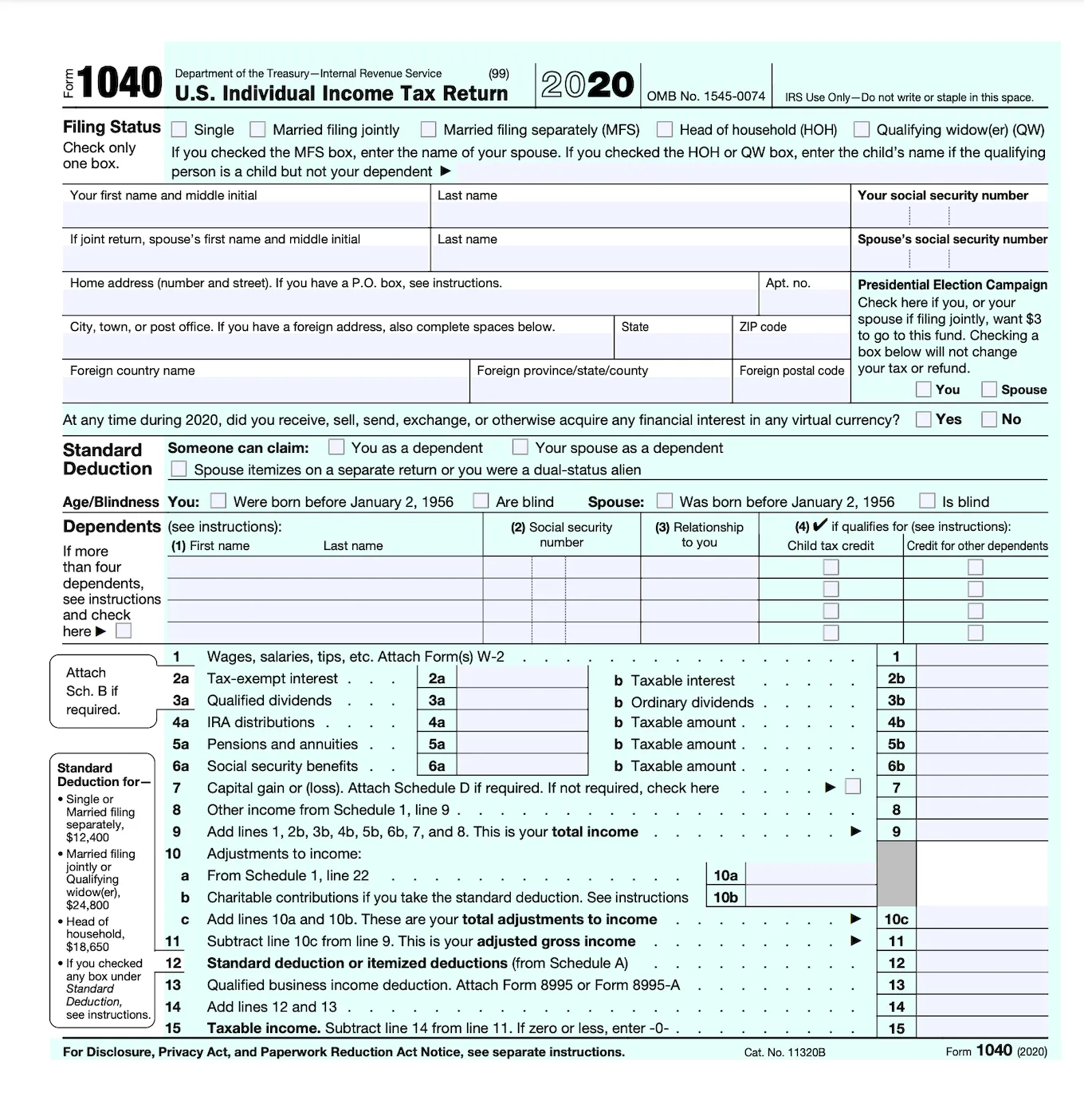Table of contents
Taxes can be an overwhelming time of the year. With so many forms to keep track of, looking ahead to what you might need for your business’s annual tax filings can save a last-minute scramble. If you are a self-employed small business owner, a member of a partnership, a single-member LLC, or a small business owner who runs your company as a sole proprietor, you may need to file Form 1040. Here’s what you need to know:
What is Form 1040?
Form 1040
Form 1040 is a two-page document used for annual income tax returns. While most taxpayers use Form 1040 to file taxes, this form is also relevant for small businesses with assets under $10 million. Form 1040 should be filed on April 15. However, due to extended deadlines in 2024, this date is subject to change. The form will require you to share personal data such as your Social Security Number and tax calculations that include income, standard or itemized deductions, taxable income, and more.
Form 1040-SR
If you’re 65 or older by the end of the tax year, you have the option of using Form 1040-SR instead of the standard Form 1040. Form 1040-SR is almost identical to Form 1040 except that it is easier to read, with a larger font and a simplified design. It also clearly shows specific benefits for taxpayers over 65, including the additional standard deduction.
Form 1040-NR
Form 1040-NR is used by nonresident ‘aliens’ who earn income from U.S. sources, engage in trade or business within the U.S., or have other tax obligations under U.S. law. The form is largely the same as Form 1040, with the main difference being the residency status of the taxpayer.
Form 1040-X
If you discover a mistake after filing Form 1040, Form 1040-SR, or Form 1040-NR you can use Form 1040-X to correct the error. Some common reasons why you might want to use Form 1040-X include changing your filing status — for example if you wish to file as an individual or jointly with your spouse — adjusting deductions and credits, or amending your number of dependents. It shouldn’t be used to correct simple calculation errors as the IRS will correct these while processing your return. To receive a refund, the form must be filed within three years after the original return was filed, or two years after the tax was paid.
Do I need to fill out Form 1040?
If you work or earn income in the U.S., you will almost certainly need to file Form 1040, regardless of whether you’re a U.S. citizen, a resident alien, or a nonresident alien with income sources in the country.
However, the earnings threshold for filing Form 1040 or one of its variants depends on your age and filing status. For example, in 2023, if you were single and under 65, you only needed to file Form 1040 if you earned $13,850 or more in the tax year.
How do I file Form 1040?
The IRS offers a downloadable version of Form 1040 that you can download and fill out, but if you are using a tax software program, there is likely an option to walk through the filing step by step. Whether you fill out the form through IRS Free File, use tax software, or hire a professional tax preparer, there are several options for filing Form 1040.

How do I figure out my deductions?
You can choose standard or itemized deductions in your return. Most choose standard deductions but if your itemized deductions are higher than the standard deduction values, you can itemize these in Schedule A. These may include things like mortgage interest payments, charity donations, and medical or dental expenses. These are different from self-employed deductions, which are included in Form 1040 Schedule C.
How do I calculate my tax liability?
There are a couple of steps involved in calculating how much tax you owe. The best place to start is by working out your total taxable income for the relevant tax year. To do this, take all your earnings for the year and deduct your standardized or itemized deductions as follows:
Key takeaways
Taxable income: gross income – standard or itemized deductions
Once you have your taxable income, you can calculate how much income tax you owe. Simply multiply your taxable income by the income tax rate.
Income tax: taxable income x tax rate
Finally, deduct any tax credits or withholdings from your income tax and that will leave you with your total tax liability. Tax credits are money you subtract directly from the taxes you owe to the government, such as the Child Tax Credit. Tax withholdings are amounts that are deducted from your gross wages by your employer and paid directly to the government on your behalf. For example, federal income tax, state income tax, and Social Security and Medicare Tax.
Tax liability: income tax – credits – withholdings
What is Schedule C for Form 1040?
There are several schedules for Form 1040. Of these, Schedule C and Schedule C-EZ may be relevant to your small business tax filings. While taxpayers typically file annually, if you are a small business owner, you may need to file an additional Schedule along with your Form 1040.
For sole proprietorships or LLCs where you are the sole owner, Form 1040 Schedule C, for example, allows you to report your business income and expenses as an attachment to your personal income tax return. This form allows you to report income or loss from your business.
Below is a breakdown of all the schedules associated with Form 1040 and 1040-SR.
| Schedule for Form 1040 and Form 1040-SR | More about the Schedule |
|---|---|
| Schedule A – Itemized Deductions | This schedule is used by filers to report itemized deductions. |
| Schedule B – Interest and Ordinary Dividends | This schedule is used by filers to report interest and ordinary dividend income. |
| Schedule C – Profit or Loss from Business (Sole Proprietorship) | Form 1040 Schedule C is used to report income or loss from a business operated or a profession practiced as a sole proprietor. |
| Schedule C-EZ – Net Profit from Business (Sole Proprietorship) | Schedule C-EZ is used instead of Schedule C by qualifying small businesses and statutory employees with expenses of $5,000 or less. |
| Schedule D – Capital Gains and Losses | Schedule D is used to report sales, exchanges, or some involuntary conversions of capital assets, certain capital gain distributions, and nonbusiness bad debts. |
| Schedule E – Supplemental Income and Loss | Schedule E is used to report income from rental properties, royalties, partnerships, S corporations, estates, trusts, and residual interests in REMICs. |
| Schedule EIC – Earned Income Credit | Schedule EIC (Form 1040 or 1040-SR) is used by filers who claim the earned income credit to give the IRS information about the qualifying child. |
| Schedule F – Profit or Loss from Farming | Schedule F (Form 1040) is used to report farm income and expenses. |
| Schedule H – Household Employment Taxes | Schedule H is used by household employers to report household employment taxes. |
| Schedule J – Income Averaging for Farmers and Fishermen | Schedule J is used to figure your income tax by averaging all or part of your taxable income from your trade or business of farming or fishing. |
| Schedule R – Credit for the Elderly or the Disabled | Schedule R (Form 1040) is used to figure the credit for the elderly or the disabled. |
| Schedule SE – Self-Employment Tax | Schedule SE (Form 1040) is used by self-employed persons to figure the self-employment tax due on net earnings. |
| Schedule 8812 – Additional Child Tax Credit | Schedule 8812 (Form 1040) is used to figure the additional child tax credit. |
![]()











